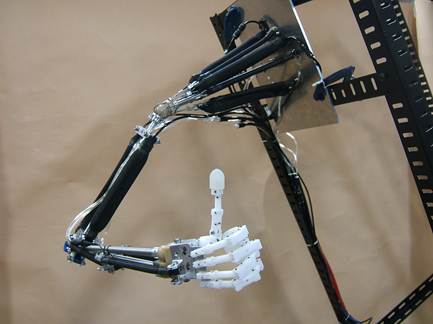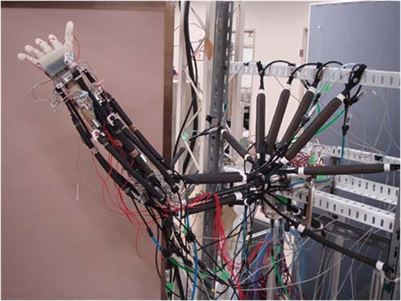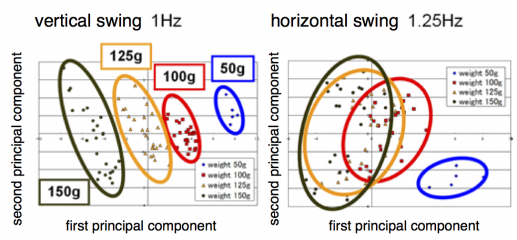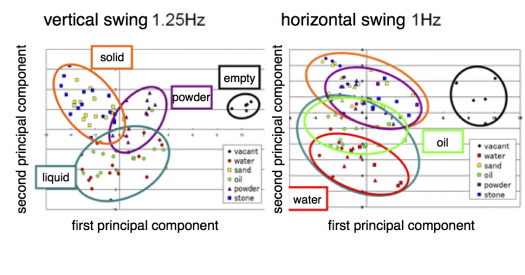A Human Upper-Extremity based Robot with 6 Degrees of Freedom

Fig. 1. An human upper-extremity based robot with 6 degrees of freedom.
After some success developing two legged robots with humanoid open joints, we decided to apply this expertise to explore the relationship between objects manipulation and human cognitive function. This way, developing a robot with a structure resembling a human upper-extremity (as seen in Fig. 1), we can have a system that allows us to control the position and orientation of the hand in 6 degrees-of-freedom. This is possible due to the 3 degrees-of-freedom from the elbow joint, combined with one from the elbow joint and two from the wrist. Particularly, the tip of the elbow uses the concepts developed in sections 1,2 and 3, faithfully reproducing the forearm structure with ulna and radius relative pronation movement. With this arm we achieved experimentally a smooth ballistic motion with a simple open-loop control. From this complex structure, the simple act of gripping an object can be used to categorize an object by shaking it periodically, in what is called dynamic touch. This behavior, which is observed in infant stage of development, allows a robot to acquire information about its dynamic behavior even without visual inputs. This study is reported in [takamuku2008].
Before this complex structure a more simplified upper-extremity, with only one joint, was developed as a prototype, approaching this cognitive problem. Our next step from the 6 degrees of freedom is the ongoing development of the 7 degrees of freedom humanoid robot, also using artificial pneumatic muscles for motion generation (Fig. 2). Our robotic arm uses pressure sensors for measuring internal pressure and strain gauges for the contraction force measurement (proprioceptive sensing), feeling each muscle as a dynamic touch does. In addition to this complex arm we chose to attach a hand with 10 joints and strain gauges attached to the fingers to measure contact force with the target object. The system is underactuated, using cables to move the fingers, resembling the human “tendon-sheath” mechanism.

Fig. 2. Humanoid robotic hand.
We also created a humanoid robotic hand capable of identifying an object by waving it. Experiments were made using water, oil, wheat flour, sand and different types of stones, totally 18 bottles with weights between 100g and 150g, and the robot had to grasp it, waving it vertically or horizontally in a 1 Hz or 1.25 Hz frequency (as shown in Fig. 3). The synergy of all sensors combined with different ways of shaking the object (directions and/or frequency) allowed us to not only identify the weight inside the bottle, but also the content.
Fig. 3. Results of identification of content though Dynamic Touch


